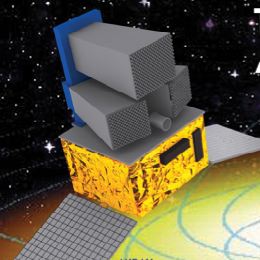Second LOFT Science Meeting

Thermonuclear burst spectroscopy with LOFT (0.7 MB PDF)

![]() GOTO |
MINBAR |
Monash astrophysics |
OzGRav |
JINA-CEE |
IGDORE |
vcard |
CV |
wiki
GOTO |
MINBAR |
Monash astrophysics |
OzGRav |
JINA-CEE |
IGDORE |
vcard |
CV |
wiki


Thermonuclear burst spectroscopy with LOFT (0.7 MB PDF)
 As reported by NASA,
the
Rossi X-ray Timing Explorer has made its last observation, on January
3rd this year. The spacecraft, launched in December 1995, had a
tremendous impact on the study of accreting neutron stars, which has been
celebrated this week with a
special session at the
219th AAS meeting in
Austin, Texas. RXTE played a
very personal role for me, having practically made my career; my
PhD thesis was largely based on early observations of a high-magnetic field
accretion-powered pulsar. Since then I've analysed many thousands of hours
of data on millisecond pulsars, thermonuclear burst sources, and other exotica,
and most of my published work has been based on these analyses.
The loss of RXTE means the end to fast X-ray timing for the time
being, at least until the much-anticipated launch of India's
ASTROSAT satellite.
As reported by NASA,
the
Rossi X-ray Timing Explorer has made its last observation, on January
3rd this year. The spacecraft, launched in December 1995, had a
tremendous impact on the study of accreting neutron stars, which has been
celebrated this week with a
special session at the
219th AAS meeting in
Austin, Texas. RXTE played a
very personal role for me, having practically made my career; my
PhD thesis was largely based on early observations of a high-magnetic field
accretion-powered pulsar. Since then I've analysed many thousands of hours
of data on millisecond pulsars, thermonuclear burst sources, and other exotica,
and most of my published work has been based on these analyses.
The loss of RXTE means the end to fast X-ray timing for the time
being, at least until the much-anticipated launch of India's
ASTROSAT satellite.

Thermonuclear burst spectroscopy with LOFT (9.4 MB Power Point)
 In December I attended the MIRAX workshop at INPE in São José dos Campos, Brazil. This is a nice, small-scale mission to be launched in 2010/11 which will use the BeppoSAX flight spare WFC camera, as well as a wide-field hard X-ray detector to be built by UCSD. Lots of interesting talks about X-ray transients and the science you can do with dedicated, long-term monitoring. Amongst the current and past monitoring projects mentioned are
In December I attended the MIRAX workshop at INPE in São José dos Campos, Brazil. This is a nice, small-scale mission to be launched in 2010/11 which will use the BeppoSAX flight spare WFC camera, as well as a wide-field hard X-ray detector to be built by UCSD. Lots of interesting talks about X-ray transients and the science you can do with dedicated, long-term monitoring. Amongst the current and past monitoring projects mentioned are
 Suzaku (aka ASTRO-EII)
successfully entered its intended orbit early this morning (local time),
according to a JAXA Press Release. All stations (Christmas
island, Santiago, and Uchinoura) have confirmed detection of the signal indicating
the satellite's separation from the launcher.
Suzaku (aka ASTRO-EII)
successfully entered its intended orbit early this morning (local time),
according to a JAXA Press Release. All stations (Christmas
island, Santiago, and Uchinoura) have confirmed detection of the signal indicating
the satellite's separation from the launcher.
Suzaku, like ASCA, is the name of a legendary bird god. ASTRO-EII is the replacement for the unsuccessful ASTRO-E satellite, destroyed shortly following launch in Feburary 2000. ASTRO-EII will cover the energy range 0.2 - 600 keV with the three instruments, X-ray micro-calorimeter (X-ray Spectrometer; XRS), X-ray CCDs (X-ray Imaging Spectrometer; XIS), and the hard X-ray detector (HXD).
The operational status will be confirmed in about 5 days. Congratulations JAXA!
UPDATE Unfortunately, the liquid helium for the cryogenically-cooled XRS unexpectedly evaporated during initial operations, rendering it useless. The active lifetime for this instrument was expected to be 2 years. The ASTRO-EII team are expected to announce a new call for proposals with the remaining science instruments in January.
See the Quicktime launch video
Astro-E2 Guest Observer Facility at HEASARC